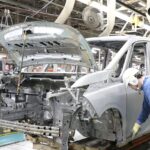Astronomers Unveil 49 New Galaxies In Record Time

New Galaxies Nicknamed The ‘49ers’
An international team of astronomers has made a groundbreaking discovery, identifying 49 previously unknown gas-rich galaxies within just three hours of observation.
Led by Dr Marcin Glowacki from Curtin University, Western Australia, the team made remarkable findings by using the powerful MeerKAT radio telescope in South Africa.
While initially focusing on studying star-forming gas in a single radio galaxy, Dr Glowacki and his team stumbled upon a treasure trove of galaxies during their analysis.
The data revealed the presence of gas in 49 galaxies, showcasing MeerKAT’s unparalleled capability in astronomical research.
“This discovery underscores the extraordinary potential of instruments like MeerKAT in unravelling the mysteries of the cosmos,” said Dr Glowacki.
Galactic Phenomena
The swift observations, made possible with the assistance of the Inter-University Institute for Data Intensive Astronomy (IDIA), have opened new avenues for exploring galactic phenomena.
The new galaxies have been informally nicknamed the ‘49ers’, a reference to the 1849 California gold rush miners. Dr Glowacki views the 49 new galaxies as valuable as gold nuggets in our night sky. Many of these galaxies are clustered, forming galaxy groups, with some linked by their gas content.
Watch the video:
Of particular interest are three galaxies intricately connected by their gas emissions. Dr Glowacki said: “Studying these galaxies across different wavelengths revealed a bustling hub of star formation in the central galaxy, possibly fuelled by gas siphoned from its companions.”
Professor Ed Elson from the University of the Western Cape, a co-author of the study, emphasised the instrumental role of MeerKAT as an imaging powerhouse. The innovative techniques developed during this research hold promise for future large-scale surveys and focused investigations.
Further bolstering their findings, Dr Glowacki and his team, including ICRAR summer student Jasmine White, continue to uncover more gas-rich galaxies. Their ongoing efforts aim to enrich our understanding of the universe and share these revelations with the global scientific community.
The findings, published in the Monthly Notices of the Royal Astronomical Society, mark a significant milestone in radio astronomy.
The International Centre for Radio Astronomy Research (ICRAR), a joint venture between Curtin University and The University of Western Australia, is pivotal in advancing astronomical research.
With its expansive campus network spanning Western Australia and global locations, Curtin University remains at the forefront of astronomical exploration.
The MeerKAT radio telescope near Carnarvon, South Africa, heralds a new era in radio astronomy, paving the way for the future Square Kilometre Array (SKA) telescope.
Through partnerships like IDIA, South African universities are equipped to lead the charge in data-intensive astronomical research, further propelling humanity’s quest to unravel the universe’s secrets.
Featured image: The MeerKAT radio telescope near Carnarvon, South Africa. Credit: ICRAR













